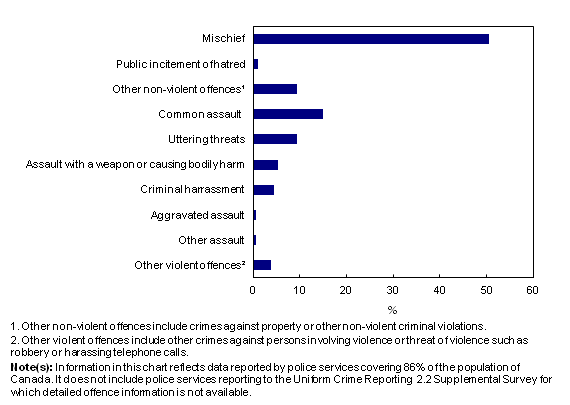Police-reported hate crimes, 2011
Archived Content
Information identified as archived is provided for reference, research or recordkeeping purposes. It is not subject to the Government of Canada Web Standards and has not been altered or updated since it was archived. Please "contact us" to request a format other than those available.
Released: 2013-07-11
Police-reported hate crimes declined for a second consecutive year in 2011. Canadian police services reported 1,332 hate crimes in 2011 or 3.9 hate crimes per 100,000 population. The rate was 5% lower than in 2010.
In 2011, three primary motivations accounted for over 95% of hate crimes, with race or ethnicity representing over half (52%) of the total, followed by religious hate crimes at 25% and crimes motivated by sexual orientation at 18%.
Police-reported hate crimes motivated by religion (-17%) and race or ethnicity (-4%) both fell between 2010 and 2011, while there was a 10% increase in police-reported hate crime incidents motivated by sexual orientation. A decline in hate crimes motivated by religion or race and ethnicity and an increase in hate crime motivated by sexual orientation were also reported between 2009 and 2010.
Although hate crimes motivated by religion and race or ethnicity have declined, some aspects of these crimes remained constant. For example, among hate crimes related to race or ethnicity, black populations are still the most frequently targeted (21% of hate crimes of all types). For religiously motivated hate crime, there has also been little change over time, with hate crimes targeting Jewish populations continuing to be the most common (15% of hate crimes of all types).
Mischief is the most common police-reported hate crime
Overall, the majority of hate crimes reported by police involved non-violent offences. Mischief, which includes vandalism, graffiti and other destruction of property, was the most commonly reported offence among police-reported hate crimes, making up half (50%) of all hate crime incidents. This was especially true for religious hate crimes, where 75% involved mischief. The number of non-violent hate crimes fell 16% between 2010 and 2011, driving the overall drop in hate crimes.
At the same time, however, the proportion of hate crimes involving violent offences, such as assault and uttering threats, increased from 34% in 2010 to 39% in 2011. This rise was accounted for by increases in the number of violent hate crimes involving race and, to a lesser extent, sexual orientation. Hate crimes motivated by sexual orientation were the most likely to involve violent offences (65%).
Both accused and victims of hate crime often young
Young adults were the most likely to be either the victim or accused of a hate crime. Among persons accused of hate crimes in 2011, 60% were under the age of 25 compared with 41% for crimes in general.
Hate crimes motivated by sexual orientation had the highest proportion of accused under the age of 25 (70%). Of the three major motivations, religiously motivated hate crime had the highest proportion of accused aged 45 and over (24%).
Those accused of hate crimes were predominantly male (88%). Among hate crimes motivated by sexual orientation, 92% of the accused were male.
In 2011, 41% of hate crime victims were under the age of 25. Victims of hate crimes motivated by sexual orientation tended to be younger, with 50% under the age of 25.
Most police-reported hate crimes occur in major cities
The majority (79%) of police-reported hate crimes in Canada occurred in major cities (census metropolitan areas, CMAs). Overall, the 10 largest cities in Canada, representing just over half of the population, accounted for 64% of police-reported hate crimes in 2011.
Toronto, Montréal, and Vancouver, the three largest CMAs in Canada, accounted for 38% of police-reported hate crime incidents. These three CMAs, however, did not have the highest rates of police-reported hate crime. The highest rates of hate crime in 2011 were in Peterborough (17.9 per 100,000 population) and Hamilton (15.9 per 100,000 population).
Note to readers
Police-reported hate crimes refer to criminal incidents that, upon investigation by police, are determined to have been motivated by hate toward an identifiable group. The incident may target race, colour, national or ethnic origin, religion, sexual orientation, language, sex, age, mental or physical disability, or other factors such as profession or political beliefs.
Police-reported hate crime data have been collected on an annual basis since 2006 and, as of 2011, cover 99% of the population of Canada.
Fluctuations in the annual number of incidents can be influenced by changes in local police service practices and community involvement, as well as the willingness of victims to report incidents to police. The number of hate crimes presented in this release likely undercounts the true extent of hate crime in Canada, as not all crimes are reported to police. Self-reported victimization data from Canadians suggest that about one-third (34%) of incidents perceived by respondents to have been motivated by hate were reported to police.
The Juristat article "Police-reported hate crime in Canada, 2011" (Catalogue number85-002-X) is now available. From the Browse by key resource module of our website under Publications, choose All subjects, then Crime and justice, and Juristat.
Contact information
For more information, or to enquire about the concepts, methods or data quality of this release, contact us (toll-free 1-800-263-1136; infostats@statcan.gc.ca) or Media Relations (613-951-4636; statcan.mediahotline-ligneinfomedias.statcan@canada.ca).
- Date modified:


